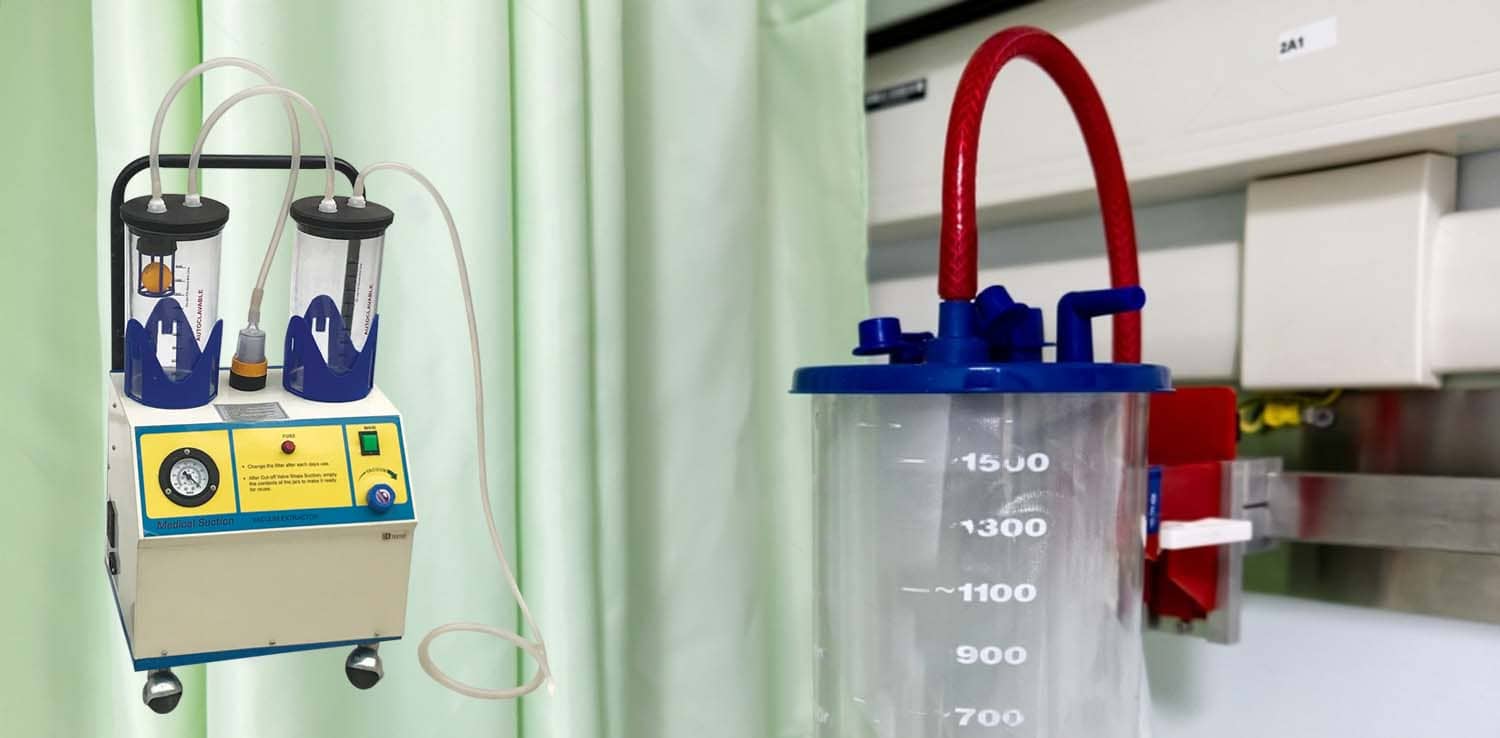A suction machine, also known as an aspirator, is a medical device used to remove substances such as mucus, blood, saliva, and other secretions from a patient’s airway or surgical site. These machines create a vacuum to draw out these fluids, which can obstruct breathing or interfere with surgical procedures.

Here are some key uses and functions of suction machines in various medical settings:
Primary Uses of Suction Machines
Airway Management
- Clearing the Airway: Suction machines are vital for clearing a patient’s airway of secretions that could block the flow of air, especially in cases of respiratory distress or during intubation.
- Emergency Situations: In emergency settings, such as after a trauma or during cardiac arrest, suction machines are used to quickly remove vomit, blood, or other obstructions to ensure the airway remains clear.
Surgical Procedures
- Surgical Site Clearance: During surgeries, particularly those involving the chest, abdomen, or head, suction machines help maintain a clear surgical field by continuously removing blood and other fluids.
- Postoperative Care: After surgery, these machines can be used to remove fluids from surgical drains or to prevent aspiration pneumonia by clearing secretions from the airway.
Medical Conditions
- Chronic Illnesses: Patients with chronic respiratory diseases, such as chronic obstructive pulmonary disease (COPD) or cystic fibrosis, often require regular suctioning to manage secretions and maintain airway patency.
- Neurological Conditions: Patients with neurological impairments, such as those resulting from a stroke or spinal cord injury, may have difficulty swallowing and clearing secretions, necessitating the use of a suction machine.
Home Healthcare
- Home Use: Portable suction machines are available for home healthcare use, enabling patients with chronic conditions to manage their secretions and maintain their airway independently or with the help of caregivers.
Components of a Suction Machine
- Pump: Creates the vacuum needed to draw fluids.
- Collection Canister: Collects the aspirated fluids.
- Tubing: Connects the suction catheter to the collection canister and pump.
- Suction Catheter: The tube inserted into the patient’s airway or surgical site to remove fluids.
- Regulator: Controls the pressure and suction strength to ensure safe and effective operation.
Types of Suction Machines
- Manual Suction Devices: Often used in emergency situations where electricity is not available.
- Portable Suction Machines: Battery-operated or handheld devices suitable for use in ambulances, at home, or during transport.
- Stationary Suction Units: Larger, more powerful machines typically used in hospitals and surgical centers.
Safety and Maintenance
- Sterility: Regular cleaning and sterilization of the machine and its components are crucial to prevent infections.
- Routine Checks: Ensuring the device is in good working condition, including checking the vacuum pressure and inspecting for any damage or wear in the tubing and canister.
- Proper Training: Healthcare providers and caregivers should be adequately trained to use suction machines safely and effectively.
Suction machines are essential tools in both emergency and routine medical care, providing critical support in managing airways and maintaining clear surgical fields. Their versatility and importance in patient care, particularly in respiratory and surgical contexts, make them indispensable in modern healthcare.
Suction Machines: Understanding Their Functions
Understanding the functionality of suction machines involves grasping how they operate, their key components, and the principles behind their use. Here’s a detailed breakdown:
How Suction Machines Work
Suction machines operate by creating a negative pressure (vacuum) that draws fluids and secretions away from the body and into a collection canister. This process is essential for maintaining clear airways and clean surgical fields.
Key Components and Their Functions
Pump
- Purpose: The pump is the core component that creates the negative pressure needed for suction.
- Types: Pumps can be electric (most common), battery-operated (portable units), or manual (hand-operated for emergency use).
Collection Canister
- Purpose: Collects the aspirated fluids, such as mucus, blood, and other secretions.
- Features: Typically made of transparent plastic to monitor fluid levels; often has markings to measure the volume of collected fluids.
Tubing
- Purpose: Connects the suction catheter to the collection canister and pump.
- Specifications: Needs to be flexible, durable, and properly sized to ensure efficient suction without blockages.
Suction Catheter
- Purpose: The tube that is inserted into the patient’s airway, wound, or surgical site to remove fluids.
- Variety: Available in different sizes and designs (e.g., Yankauer, French) to suit specific medical needs.
Regulator
- Purpose: Controls the amount of suction pressure to ensure it is within safe and effective limits.
- Adjustability: Allows for fine-tuning based on the procedure and patient’s condition.
Filters and Valves
- Purpose: Prevent contamination and backflow of fluids.
- Types: Bacterial filters to prevent infections; one-way valves to maintain consistent suction flow.
Principles of Operation
Creating Negative Pressure
- The pump generates negative pressure, causing air to be sucked out of the collection canister, creating a vacuum.
- This vacuum draws fluids through the suction catheter and tubing into the canister.
Fluid Collection and Disposal
- Fluids are collected in the canister, which is designed to be easily detached and emptied.
- Canisters often have anti-overflow mechanisms to prevent spillage and contamination.
Pressure Regulation
- The regulator ensures that the suction pressure is appropriate for the specific application, preventing damage to tissues.
- Different medical situations require different levels of suction pressure; for example, delicate procedures like neonatal suctioning require lower pressures.
Specific Applications
Airway Management
- Use Case: Clearing obstructions such as mucus, blood, or vomit to ensure a patent airway.
- Method: Suction catheter is inserted into the mouth, nose, or tracheostomy tube.
Surgical Procedures
- Use Case: Maintaining a clear view of the surgical site by removing blood and other fluids.
- Method: Continuous or intermittent suctioning during surgery.
Postoperative Care
- Use Case: Preventing aspiration and managing secretions in patients unable to clear their airways independently.
- Method: Regular suctioning using portable or stationary units.
Chronic Conditions
- Use Case: Long-term management of secretions in patients with respiratory conditions like COPD or cystic fibrosis.
- Method: Home-use portable suction machines operated by the patient or caregiver.
Maintenance and Safety
Cleaning and Sterilization
- Regular cleaning of tubing, canisters, and catheters to prevent infections.
- Use of disposable components where possible to enhance hygiene.
Routine Checks
- Regular inspection of the pump, tubing, and connections for wear and tear.
- Ensuring that filters are clean and replaced as needed.
Proper Training
- Healthcare providers and caregivers must be trained in the correct operation and troubleshooting of suction machines.
- Awareness of the appropriate suction pressures for different procedures to avoid tissue damage.
Conclusion
Suction machines are vital in various medical settings, ensuring patient safety and effective care. Understanding their functionality, components, and proper usage is crucial for healthcare professionals to utilize these devices efficiently and safely. Regular maintenance and training are essential to ensure these machines remain reliable and effective in critical situations.
